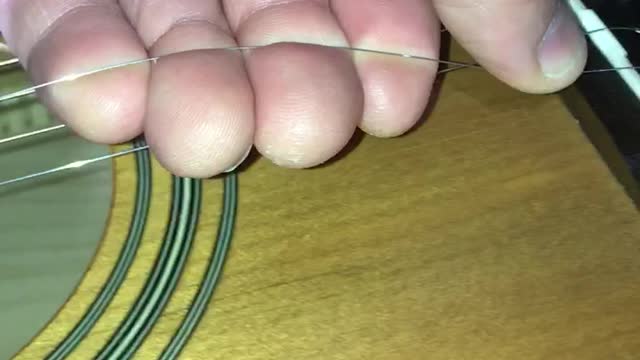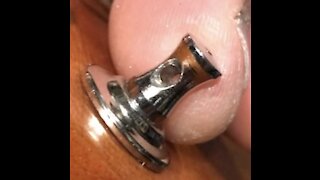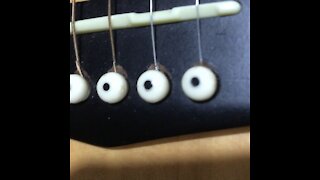Premium Only Content

How To Stretch Brand New Guitar Strings - Guitar Maintenance and Repair
In this video, we talk about string stretching.
Brand new strings will stretch quite a bit, and this can be a problem when you are trying to play guitar and every time you bend a string, the string stretches a little bit and goes flat.
Multiply this problem by 6 strings...
So to help alleviate this problem, we stretch the brand new strings during the string change.
There is a fine line between over-stretching and under-stretching, so always try to err on the side of under-stretching, meaning you should only stretch the string maybe 2-4 times, instead of 20-30 times.
Some people will stretch the string, move their hand an inch, stretch, move, stretch, etc
In my opinion, this creates a situation where every inch you have an alternating pattern of a small section of “stretched string”, and “not-stretched” string.
Maybe thats a good thing?
Its the imperfections we love, so maybe an unevenly stretched string sounds better to our ears?
Different harmonic colors?
Let me know what you think in the comments below.
But anyway, presuming that you *want* a string that is stretched evenly...
Think about the string for its entire length, from bridge to tuning peg.
At the bridge, the string usually crosses over a sharp corner, leaving a mico-dent or mico-kink in the string.
If you continue to stretch the string, eventually you will pull that damaged part of the string forward, and you’ll have (another) imperfection in the vibrating length of the string...
This is why its so important to get the ball end of the string properly seated before you tighten string.
If ball end isn’t seated, and then tightening string causes the ball end to move up 1/8”, then the section of string that was just moments before being damaged by crossing the bridge, will now be 1/8” into the vibrating length of the string.
This has never bothered me enough to change the string, but if i was doing a job for pay, or paying someone to do the job, there should be no string damage like this on a brand new string job.
On the tuning peg, a string with a round cross section has to go around the radius of a peg, creating an uneven stretch on the string, between the inner diameter, and outer diameter of the string.
Multiply this by the number of wraps the string goes around the peg, and more headaches.
So, when installing strings, make strings slightly shorter, so you get ~ 2 wraps instead of 6 wraps
Even as the string passes over the nut, there will be places where the string is stretched unevenly.
For the vibrating length of the string, there will continue to be stretching going on, probably more toward the middle of the string, where bends are made, as opposed to bridge or nut end, where bends are not made.
Even along the middle of the string, the string bends made during normal guitar playing will be made at the frets, creating this situation of alternating stretched-not-stretched pattern on the string that we were trying to avoid...
So a few things you can do are
1) inspect the tuning pegs when the strings are off, and make sure they are smooth and free of irregularities.
2) inspect the nut, and smooth out any rough contact points.
3) inspect the saddle, bridge, and bridge pin holes, or tail piece, and smooth any rough contact points.
4) theres not much you can do about uneven stretching around tuning pegs, nut, bridge etc other than make fewer string winds on the tuning pegs, and lube contact points.
5) As for the vibrating section of the string, think of stretching the string as one continuous motion, that stretches the entire length of string evenly from end to end.
Depending on the strings, some strings you can actually feel the string kind of crinkle, or snap, crackle, pop, under your thumb.
Im not sure what causes this, but i tell myself that there are micro-tensions that are built into the string during the manufacture and packaging of strings.
For example, if a string is manufactured or stored in a coil, its going to want to stay in a coil.
This is why we inspect each new string when we take it out of the pack, and let it hang straight down, and look for any coiling, and then gentle run our fingers down the length of the string a few times to try and get the string to hang perfectly straight down.
Even after the string is installed, there are still millions (billions?) of micro-atomic level spots within the string, where there is string tension or ‘memory’ in the metals.
By stretching in one continuous motion, you get to feel the string stretch for the entire length of string, and you’ll be able to release far more of these micro-tensions with this method.
How do we know?
Because on the first, you’ll feel the string crinkle for the entire length of string,
But on the second pass, there will still be crinkling, but not nearly as much.
By the third pass, the crinkling may have stopped.
It just seems to me that the strings just feel and sound better when you stretch the strings this way.
The strings feel silky and smooth,
And when you are playing, you just ‘feel’ like you are bending *an entire length of string*, as opposed to, for example, feeling like you are merely bending *a note* at the 7th fret
-
 2:46
2:46
Beginner Guitar
2 years agoA Song About The Day My Great Great Grandpa Died
491 -
 1:03
1:03
Beginner Guitar
4 years agoGuitar Maintenance and Repair - Bridge Pin Holes
222 -
 1:03
1:03
Beginner Guitar
4 years agoGuitar Maintenance and Repair - Inspecting tuning machine holes for burrs
154 -
 12:16
12:16
Flamenco4U
4 years agoEpisode 4: Flamenco Guitar Strings
59 -
 7:06
7:06
Beginner Guitar
4 years agoFinishing Guitar String Ends - Beginner Guitar Maintenance
141 -
 0:17
0:17
GuitarNut
4 years agoE A D G B E - Guitar Strings From Thick to Thin
75 -
 8:25
8:25
Friedpizzabites
4 years agoBrand New Maintenance Train at Work
191 -
 1:00
1:00
Beginner Guitar
4 years agoGuitar Maintenance - Blackening Bridge Pin Holes For Cosmetic Purposes
30 -
 14:11
14:11
TheGuitologist
4 years ago1982 MXR Distortion II Guitar Effects Pedal REPAIR
2795 -
 0:54
0:54
TRNTheRailfanNetwork
4 years agoBrand New Amtrak Maintenance Of Way Machine!
632